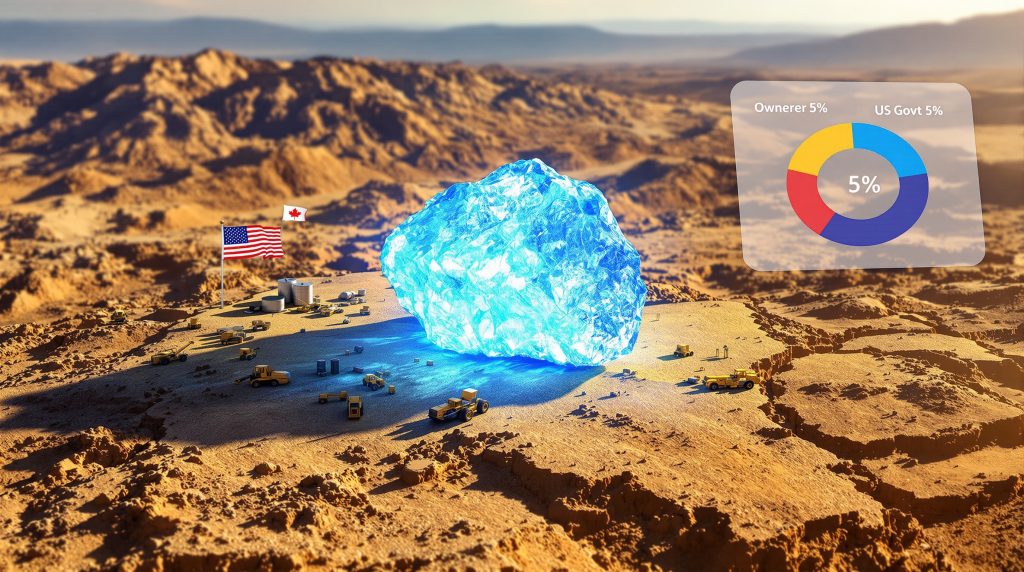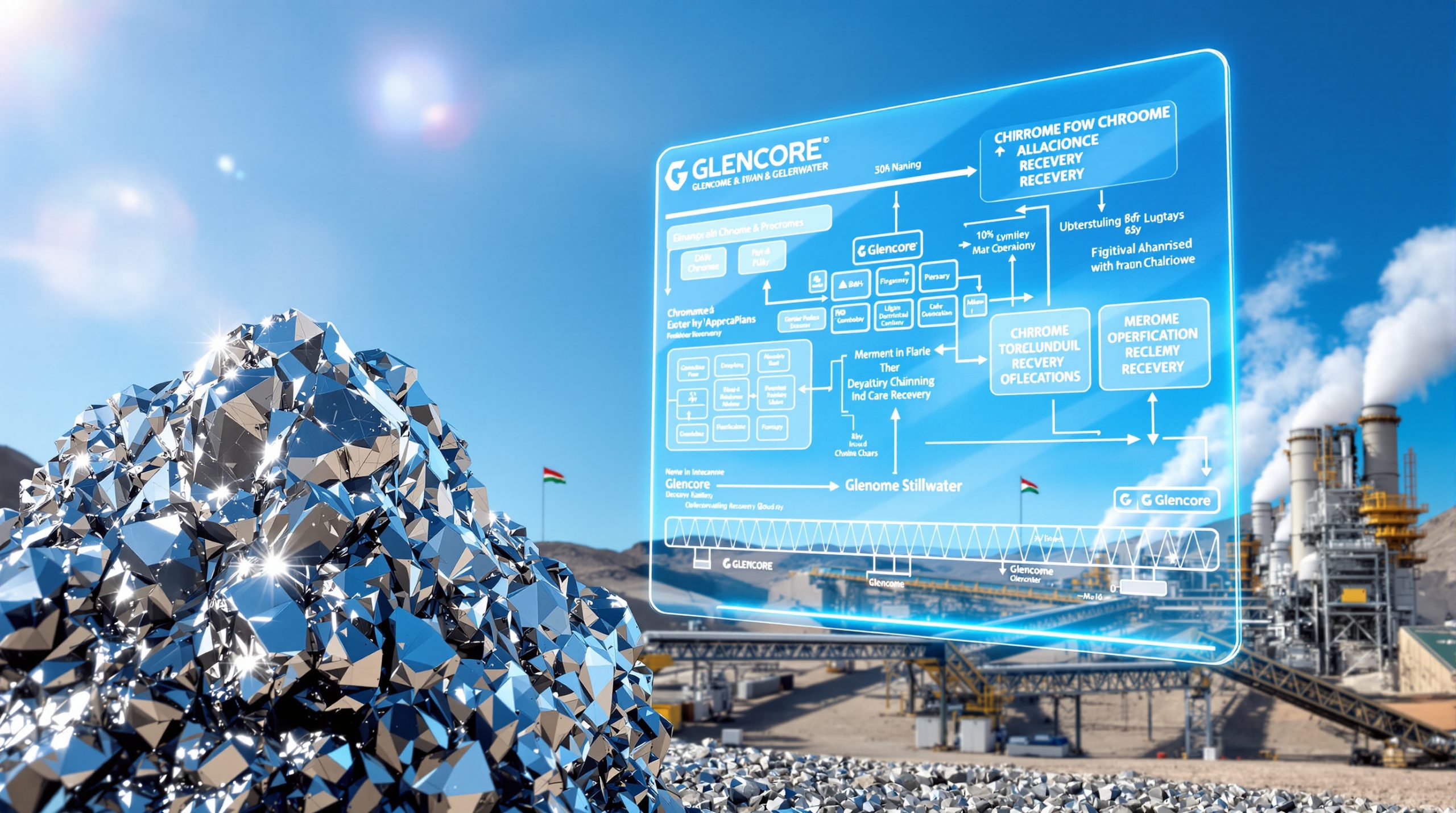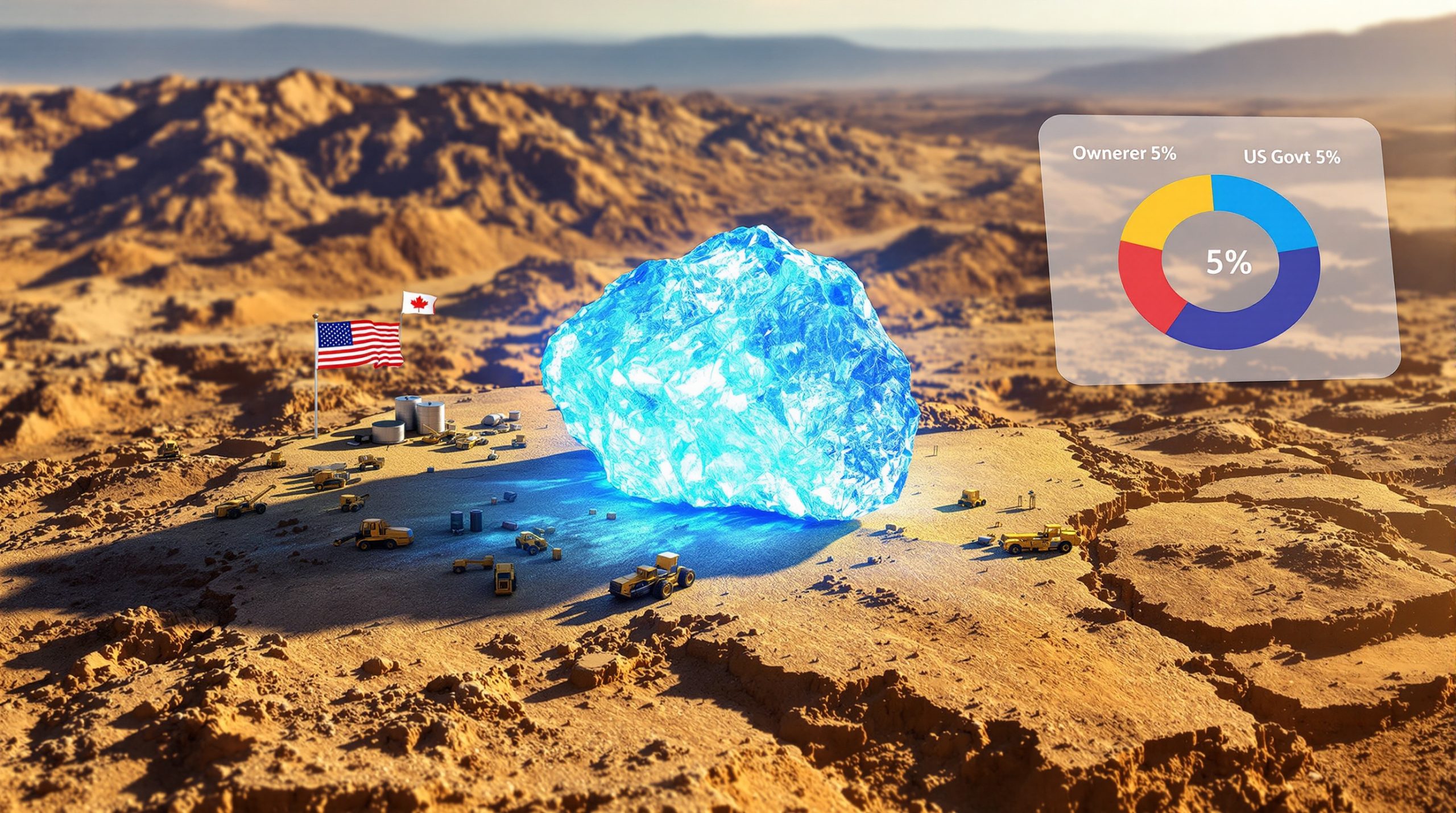US Government's Strategic Stake in Lithium Americas: Implications and Analysis
The United States government has secured a 5% equity position in Lithium Americas Corporation alongside a separate 5% stake in the company's flagship Thacker Pass lithium mining project in Nevada. This strategic investment comes as part of a comprehensive $435 million funding package from the Department of Energy (DOE), with provisions for delayed debt servicing totaling $182 million over the initial five-year period.
Key Terms of the Government Investment
- Equity Position: 5% ownership stake in Lithium Americas Corporation
- Project Stake: 5% direct ownership in the Thacker Pass mining operation
- Financial Package: $435 million in DOE loans with favorable repayment terms
- Debt Service Relief: $182 million in delayed debt servicing over five years
- Warrant Structure: Government equity secured through penny warrants
Timeline of the Investment Development
- Initial Discussions: Early-stage negotiations began following resource security assessments
- Deal Announcement: Official confirmation of the government stake in September 2025
- Market Response: 188% stock price surge within two weeks of announcement
- Current Status: Implementation phase with continued market volatility
Why is the US Government Investing in Lithium Production?
Strategic Resource Security Objectives
The Trump Critical Minerals Order has identified domestic lithium production as critical to national security and economic competitiveness. This investment represents a concrete step toward reducing dependence on foreign lithium sources, particularly from geopolitical competitors. The United States currently produces less than 5,500 short tons of lithium annually, representing a negligible fraction of global supply—a situation that creates significant vulnerabilities in domestic manufacturing capabilities.
Economic Development and Job Creation
The Thacker Pass project is projected to create over 1,000 construction jobs and 300+ permanent positions in rural Nevada, providing economic stimulus to an economically challenged region. The government stake helps ensure these economic benefits materialize while supporting broader industrial revitalization goals in critical regions.
Climate Policy Implementation
The investment aligns with federal initiatives to enhance domestic battery supply chains essential for electric vehicle manufacturing and renewable energy storage systems. Securing lithium supply is fundamental to achieving transportation electrification goals across multiple industrial sectors.
Technology Leadership Positioning
By supporting North America's largest lithium project, the government aims to establish technological leadership in battery materials processing and advanced manufacturing, countering China's dominant position in the global lithium supply chain. This move follows similar strategic investments in other critical minerals & energy security technologies.
How Does the Thacker Pass Project Compare to Global Lithium Sources?
Production Capacity and Timeline
- Projected Annual Output: 40,000 metric tons of battery-grade lithium carbonate
- EV Manufacturing Capacity: Sufficient lithium for approximately 800,000 electric vehicles annually
- Development Timeline: Construction underway with production targeted for 2028
- Mine Lifespan: Estimated 46-year operational life based on current reserves
Resource Quality Assessment
The Thacker Pass deposit contains high-grade lithium-bearing clay with favorable extraction characteristics compared to traditional brine operations. The resource quality positions it competitively against established global producers, though the clay-based extraction process introduces unique technical challenges not present in brine operations.
Environmental Impact Considerations
The project employs innovative direct lithium extraction advances designed to minimize water usage and reduce environmental footprint compared to conventional lithium operations. Government involvement includes oversight of environmental compliance, particularly important in Nevada's water-sensitive ecosystem.
Comparison to International Operations
| Aspect | Thacker Pass (US) | Australian Spodumene Operations | Chilean Brine Operations |
|---|---|---|---|
| Resource Type | Lithium-bearing clay | Hard rock spodumene | Salt flat brines |
| Water Usage | Moderate | Low | Very high |
| Processing Complexity | Medium | High | Low |
| Production Cost | Mid-range | Higher | Lower |
| Environmental Impact | Moderate | Moderate | Higher (water) |
What Are the Market Implications of Government Involvement?
Stock Performance Analysis
Following the announcement of government investment, Lithium Americas stock experienced extraordinary price movement:
- 188% price increase within two weeks
- Market capitalization exceeding $2 billion
- Trading volume spike of over 500% above average
- Price levels 40% above average analyst targets
This dramatic surge mirrors similar patterns seen with other companies receiving government support, including MP Materials (up 390% following $400 million DOD investment) and Intel Corporation (up 50% since government stake announcement).
Analyst Perspective Shift
The dramatic price movement has triggered significant reassessment among market analysts:
- Scotiabank: Downgraded from "sector perform" to "sector underperform" with recommendation to "take profits now and reload at lower levels"
- Cormark Securities: MacMurray Whale lowered rating from "buy" to "market perform," advising investors to "wait to see whether there is a pullback after this excitement"
- Morningstar Research: Reduced recommendation from "buy" to "hold" after share price bypassed price target, noting "the market's gone from overly pessimistic on the stock to now overly optimistic"
- Jefferies: Raised dilution concerns for existing shareholders
Shareholder Dilution Concerns
Financial analysts have calculated that if similar equity concessions accompany future loan drawdowns, existing shareholders could face up to 40% dilution over the coming years. This potential dilution represents a significant consideration for current investors and explains some of the analyst caution despite the stock's stellar performance.
Comparison to Other Government-Backed Companies
The Lithium Americas investment follows a pattern of strategic government stakes in critical industries:
- MP Materials: 400% stock appreciation following $400 million DOD investment
- Intel Corporation: 50% share price increase after government stake announcement
- Trilogy Metals: Recent government investment in another strategic metals producer
This pattern suggests a systematic approach to securing critical resource and technology supply chains through direct equity participation rather than traditional grants or subsidies.
How Does This Investment Impact US Lithium Supply Chain Development?
Current Domestic Production Gap
The United States currently produces less than 5,500 short tons of lithium annually, representing a negligible fraction of global supply. This production deficit creates significant vulnerabilities in domestic manufacturing capabilities, particularly for electric vehicle batteries and energy storage systems.
Supply Chain Resilience Enhancement
The Thacker Pass project, with government backing, is positioned to dramatically increase domestic lithium production, potentially reducing import dependence by up to 25% when at full capacity. This reduction directly strengthens supply chain resilience and reduces vulnerability to international supply disruptions or price manipulation.
Integration with Automotive Manufacturing
General Motors' simultaneous $625 million investment for a 38% stake in Thacker Pass creates a vertically integrated supply chain from mine to vehicle. GM has secured exclusive lithium offtake rights for 20 years, ensuring stable material supply for its expanding electric vehicle production plans, according to a recent Reuters report.
Technology Development Acceleration
Government involvement facilitates accelerated development of advanced lithium processing technologies with potential applications beyond Thacker Pass, creating spillover benefits for the broader domestic lithium industry. These technological advances could potentially be applied to other domestic lithium resources currently considered uneconomical.
What Are the Potential Risks and Challenges?
Execution and Operational Risks
Despite government backing, the project faces significant execution challenges:
- Complex permitting requirements involving multiple federal and state agencies
- Technical challenges in scaling clay-based lithium extraction, which has limited commercial precedent
- Construction timeline uncertainties in a challenging labor market
- Workforce development needs in a rural location with limited specialized mining expertise
Market Price Volatility Exposure
The lithium market has demonstrated extreme price volatility, with spot prices fluctuating by over 300% in recent years. This volatility creates revenue projection uncertainties despite government involvement and could impact the project's financial viability even with preferential financing terms.
Environmental Opposition Considerations
The project continues to face opposition from environmental groups and some indigenous communities concerned about impacts on local ecosystems and cultural resources. These challenges could impact development timelines despite federal backing, as legal challenges work their way through various jurisdictions.
Geopolitical Response Dynamics
China, which controls approximately 60% of global lithium processing capacity, may implement strategic countermeasures to maintain market dominance, potentially including price manipulation or accelerated investment in competing resources. This international dimension adds complexity to the project's long-term outlook.
What Does This Mean for Investors?
Investment Thesis Evaluation
The government stake fundamentally transforms the investment case for Lithium Americas:
- Reduced Financing Risk: Federal backing substantially lowers project financing uncertainty
- Enhanced Project Visibility: Government involvement raises profile and market attention
- Execution Support: Access to federal technical resources improves operational outlook
- Valuation Complexity: Government terms create challenges in traditional valuation models
At current trading levels—40% above average analyst price targets—many experts question whether all these benefits are already more than priced into the stock.
Short-Term vs. Long-Term Perspectives
Analysts increasingly differentiate between short-term trading opportunities and long-term investment potential:
- Short-Term View: Current valuation appears stretched following rapid price appreciation
- Medium-Term Outlook: Potential price normalization as initial excitement moderates
- Long-Term Thesis: Fundamental value proposition remains strong despite dilution concerns
This differentiated time horizon analysis helps explain why many analysts have downgraded near-term ratings while maintaining positive long-term outlooks.
Alternative Investment Considerations
For investors interested in lithium exposure, analysts suggest considering:
- Established producers with current cash flow rather than pre-production companies
- Diversified materials companies with lithium exposure alongside other critical minerals
- ETFs providing broader lithium industry participation to mitigate single-project risk
- Later-stage development projects with clearer valuation metrics
These alternatives may offer lithium market exposure with potentially better risk-reward profiles than Lithium Americas at current valuations.
How Might This Model Expand to Other Critical Minerals?
Pattern Recognition in Government Strategy
The Lithium Americas investment represents a replicable model for government support of strategic resource development. Similar approaches could be applied to:
- Rare earth element projects currently facing financing challenges
- Domestic copper development to reduce import dependence
- Nickel and cobalt resources critical for advanced battery chemistries
- Graphite and manganese production for energy storage applications
This systematic approach reflects a shift from traditional funding mechanisms to direct equity participation in strategic sectors.
Potential Future Investment Targets
Analysis of government statements and industry positioning suggests several companies may be candidates for similar arrangements:
- EVgo Inc.: Electric vehicle charging infrastructure developer identified by JPMorgan analysts
- Plug Power Inc.: Hydrogen production and fuel cell technology company also highlighted by JPMorgan
- Various early-stage critical mineral developers with strategic domestic resources
The pattern established with MP Materials, Intel, Lithium Americas, and Trilogy Metals suggests a consistent strategy likely to continue.
Legislative Framework Evolution
Recent legislative actions provide expanded authority and funding for similar strategic investments. This evolving framework suggests continued government activity in critical mineral sectors as part of a comprehensive industrial policy approach rather than isolated investments.
What Are the Broader Economic Implications?
Domestic Manufacturing Renaissance
The us government stake in lithium americas represents one component of a broader strategy to rebuild domestic manufacturing capabilities. The lithium supply chain development directly supports:
- Electric vehicle production expansion at major automakers
- Battery gigafactory development across multiple states
- Energy storage system manufacturing for grid applications
- Advanced materials production for defense and aerospace applications
These interconnected industrial sectors create multiplicative economic benefits beyond the direct mining operation.
International Trade Relationship Impact
The government's direct involvement in lithium production signals a shift toward more interventionist trade policies, potentially influencing:
- Trade negotiations with lithium-producing nations like Chile, Australia, and Argentina
- Investment screening for foreign capital in critical sectors
- Export control considerations for advanced technologies
- International standards development for battery materials
This shift has implications for both allies and competitors in global markets.
Employment and Regional Development
Beyond direct mining employment, the project is expected to generate:
- Supplier network development throughout Nevada and neighboring states
- Technical training program expansion at regional educational institutions
- Research and development investment in extraction and processing technologies
- Infrastructure improvements in transportation and energy systems
These secondary and tertiary economic benefits explain the strong political support for the project across partisan lines.
What's Next for the US Government's Critical Mineral Strategy?
Anticipated Policy Developments
Based on current trajectories, several policy developments appear likely:
- Expansion of strategic investment to additional critical minerals beyond lithium
- Enhanced permitting coordination for priority resource projects to accelerate timelines
- Increased funding for processing technology development to reduce dependence on foreign refiners
- Strengthened export controls on advanced material technologies to protect intellectual property
These developments would represent a continuation and expansion of the current approach rather than a fundamental shift.
Legislative Support Mechanisms
Congressional support for critical mineral development continues to evolve through:
- Bipartisan infrastructure funding allocations targeting mineral supply chains
- Australia lithium tax breaks serving as a model for similar incentives in the US
- Research grants for extraction technology development
- Workforce development program funding in mining regions
This legislative framework provides the foundation for continued executive action in the sector.
International Coordination Efforts
The US is simultaneously pursuing international partnerships to secure critical minerals:
- Bilateral agreements with Canada and Australia to create allied supply chains
- Multilateral frameworks with democratic allies to counter resource nationalism
- Technology sharing arrangements with processing leaders outside China
- Investment coordination in developing resource regions to diversify global supply
These international dimensions complement domestic production efforts rather than replacing them, including support for a battery-grade lithium refinery in allied nations.
FAQs About the US Government Stake in Lithium Americas
What percentage of Lithium Americas does the US government own?
The federal government holds a 5% equity stake in Lithium Americas Corporation and a separate 5% direct ownership position in the Thacker Pass project specifically.
How much lithium will Thacker Pass produce annually?
At full capacity, Thacker Pass is projected to produce approximately 40,000 metric tons of battery-grade lithium carbonate annually, sufficient for manufacturing around 800,000 electric vehicles.
Who else owns significant stakes in the Thacker Pass project?
General Motors holds a 38% stake in the project, secured through a $625 million investment, with exclusive rights to purchase lithium from the initial production phases for 20 years.
How does this government investment compare to other recent strategic investments?
This investment follows similar strategic stakes in MP Materials (rare earth magnets), Intel Corporation (semiconductor manufacturing), and Trilogy Metals (copper development), indicating a consistent pattern of government involvement in critical industries.
What are the potential downsides for existing Lithium Americas shareholders?
Financial analysts have identified potential dilution of up to 40% for existing shareholders if similar equity concessions accompany future loan drawdowns, which represents a significant consideration for current investors.
Further Exploration
Readers interested in learning more about government investments in critical minerals can explore related educational content at Bloomberg's detailed coverage, which offers additional perspectives on developments in the lithium mining sector.
The us government stake in lithium americas represents not just an isolated investment but a significant shift in industrial policy with far-reaching implications for domestic manufacturing, international trade relations, and strategic resource security. As similar deals continue to emerge, understanding this model becomes increasingly important for investors, industry participants, and policy analysts.
Ready to Spot the Next Major Mineral Discovery?
Don't miss crucial opportunities in the ASX market—Discovery Alert's proprietary Discovery IQ model delivers real-time notifications on significant mineral discoveries, helping you capitalise on potential market-moving announcements before the broader market. Explore why major mineral discoveries can lead to substantial returns by visiting Discovery Alert's dedicated discoveries page.




